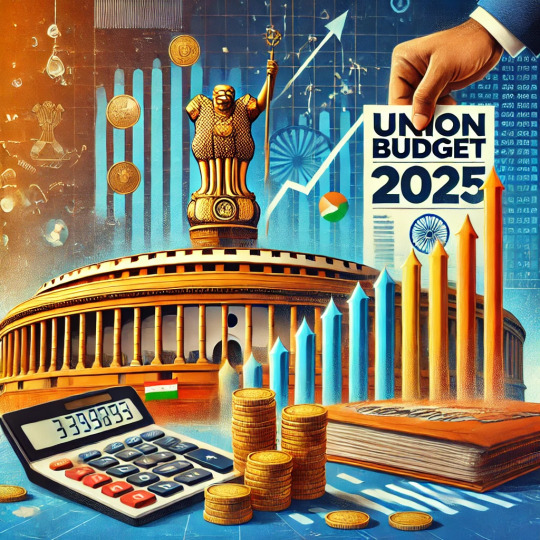#MiddleClassRelief 🏠
Explore tagged Tumblr posts
Text

My Two Cents on Budget
Understanding India’s Budget: GDP, Taxation, Banking, and Practical Growth Strategies ✨📊🇮🇳
Tomorrow is Budget Day in India—a crucial moment that shapes our economy and affects our daily lives. But to truly appreciate its impact, we must first understand how GDP, taxation, banking, and economic policies influence growth. This blog will break down these concepts in simple terms, summarize key insights from the podcast by Dr. Prasanna Tantri, and suggest practical ideas for an effective budget. 💡📈🧠
What is GDP and Why Net Value Addition Matters? 💰📉📊
GDP (Gross Domestic Product) is the total value of all goods and services produced in a country. However, the real measure of economic health is not just GDP but net value addition—the actual increase in wealth after removing the cost of raw materials and intermediate goods. 🚀🏭💡
Example:
Imagine a restaurant that buys vegetables for ₹10,000, employs a chef for ₹15,000, and earns ₹50,000 in total sales. If you only look at revenue, you might say the restaurant is doing great. But if we subtract costs (vegetables + salaries + rent), the actual profit or net value addition is what really counts. Similarly, a country must focus on increasing value-added production rather than just output. 🍽️📊💵
How Taxation Can Impact Growth Negatively 🚧💸⚖️
While taxation is necessary for government revenue, high taxes can discourage businesses and consumers from spending and investing. 📉🏢👎
Example:
If the government imposes a high tax on mobile phones, fewer people will buy them, leading to lower demand and job losses in the industry. Instead, a balanced tax system should encourage businesses to invest and expand, ultimately leading to more job creation and increased revenue through economic activity. 📱📊💼
Better Alternative:
Instead of taxing businesses heavily, the government can promote tax incentives for industries that create high employment. 🎯🏭📈
Reduce compliance burdens for small businesses to encourage entrepreneurship. 💼💰🚀
Reduce income tax for the middle class to increase disposable income, leading to higher consumer spending and more investment in housing, education, and businesses. This will spur overall economic growth and job creation. 🏡📚💵
Role of RBI in Supporting Economic Growth 🏦📉💡
The Reserve Bank of India (RBI) plays a crucial role in ensuring the economy remains stable while promoting growth. It controls interest rates, inflation, and the money supply in the market. 📊🔄🏛️
How Can RBI Help Growth? 🏦💰🚀
Lowering Interest Rates: If RBI lowers interest rates, businesses can borrow money at lower costs, invest in expansion, and create more jobs. 🏗️💸📈
Managing Inflation: Too much money in the system leads to inflation, making goods expensive. RBI ensures the right balance. 💹⚖️🛒
Ensuring Liquidity: By providing funds to banks, RBI ensures they can lend money to businesses and individuals when needed. 💳🏦💵
Practical Idea for Budget: RBI and the government can work together to provide special low-interest loans to startups and MSMEs, boosting innovation and job creation. 🚀💡🏭
Practical Suggestions 🎯📜🚀
Shift from High Taxation to High-Compliance Model
Reduce GST rates for essential and manufacturing sectors while ensuring better tax collection through AI-driven monitoring. 🏭🤖💰
Introduce “One-Nation, One-Tax Return” to simplify tax filing. 📝✅🇮🇳
Transform Agriculture into a Value-Adding Industry
Instead of just providing subsidies, promote food processing industries near farms to increase farmer earnings. 🚜🏭💵
Encourage private investment in cold storage and logistics. ❄️🚚📦
Government as a Growth Partner, Not Just a Regulator
Instead of controlling businesses through regulations, the government can provide AI-powered financial advisory services to MSMEs, guiding them towards profitable operations. 🤖💼📈
Promote local manufacturing by reducing import duties on essential raw materials. 🏭🇮🇳🔧
Tech-Enabled Public Services for Better Utilization of Funds
Use AI to track government project efficiency and reduce corruption. 🏗️🖥️🔍
Implement digital education reforms to improve the quality of education while reducing costs. 📚💻🎓
Budget in nutshell 🎙️🧠📢
India's budget must shift its focus from just GDP numbers to actual value addition. Simply producing more does not mean we are progressing—what matters is whether we are creating real wealth. 🏦💰📊
Taxation should be designed to encourage business growth rather than acting as a burden. ⚖️💼📈
RBI should use interest rate policies strategically to help industries grow while managing inflation. 📉🏗️🏛️
The government should think like an investor—spending money where it generates maximum economic returns rather than just fulfilling political promises. 🎯💡📊
Reducing middle-class income tax can enhance consumption and private investment, leading to a positive cycle of economic expansion. 💰🏡📈
The key takeaway? India’s economy needs smart policies that prioritize wealth creation, ease of doing business, and sustainable economic expansion over short-term revenue collection. 🌍📊📈
Final Thoughts 🤔📜🚀
This budget, the government has an opportunity to create a roadmap for real economic growth. By understanding taxation, banking, and net value addition, we as citizens can demand better policies and make informed decisions. Let’s hope this year’s budget takes a bold step toward a wealthier and more prosperous India! 🇮🇳📈💡
#Budget2025 📊#IndianEconomy 🇮🇳#UnionBudget 🏛️#EconomicGrowth 🚀#FinanceForAll 💰#MiddleClassRelief 🏠#TaxReforms 📉#RBIUpdates 🏦#EaseOfDoingBusiness 💼#WealthCreation 🌱#SimplifyingFinance 🤓#SmartBudgeting 🧠#GrowthMindset 📈#FutureOfIndia 🔮#BudgetForThePeople 🙌
1 note
·
View note